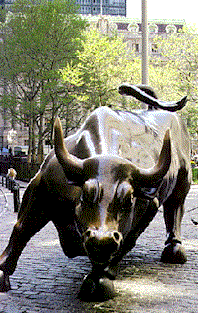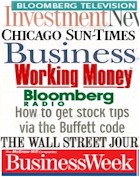|
Investment articles constantly refer to bull markets and bear
markets with headlines such as "The Great Bull Market
1982-2000" or "No Bull: It's a Bull Market"
or "Which Way to Go After a Bear Market" or "Surviving
the Bear Market".
What do these
terms mean? Bulls toss things up with their horns so
rising markets are called bull markets. A more precise
definition is that a bull market is a period when one
of the major indices has increased by at least 20%.
When this happens, we are said to be in a bull market.
In the opposite direction, bears tear
things down with their claws so falling markets are
called bear markets. As for bear markets, the more precise
definition is when one of the major indices has fallen
by 20% or more.
One of the most important indices in the
US is the Standard and Poor 500. From its peak in March
2000, the S&P 500 has fallen by about 41 per cent.
At one stage in mid-July, it was down by 48 per cent
from its peak, the largest fall since the 1930s.
Over the same period, the London market
has fallen by 34 per cent, Canada's market by 31 per
cent and Tokyo's by 45 per cent.
These are definitely bear markets.
|

The Wall Street Bull
|
What about Australia? Over the same period that
Wall Street has fallen by 41 per cent and all those other
markets have fallen by roughly similar amounts, the Ozzie
market as measured by the ASX 200 index fell by just 3 per
cent. Since the end of April, the ASX 200 index has fallen
just 9 percent, about half the decline in the US.
You may be tempted to think that the Australian
economy is independent of the rest of the world, or that it
is simply more robust.
The real answer has more to do with the different
composition of the indices. A very large proportion of the
Australian market consists of financial stocks (around 44
percent), a strongly performing sector. It is also has a negligible
weight in the poorly performing technology sector.
The authors of the August "Statement on
Monetary Policy" put out by the Reserve Bank of Australia
recalculated the indices by reweighting the sectors to match
those of the US. When this was done, the index showed a drop
of 32 percent, much the same as the overseas indices.
For example, the Information Technology sector
dropped by 91 percent in Australia and by 77 percent in the
US. But in Australia this sector makes up less than 1 percent
of the index whereas in the US it makes up 14 percent.
So there it is. The Ozzie market when measured
by standard indices had a very minor drop compared to the
US and other major markets. This is why the US and European
bears didn't make it to Australia. But on a sector by sector
basis our drops are quite similar to those of the US.
Despite the sector by sector similarities, some
fear that the modest drop we have seen is just the start and
that there is much worse to come. The Reserve Bank also considered
this. They calculated that the average price-earnings ratio
has risen since late 2001 from around 20 to 27. If this was
the end of the story then it would be a definite worry.
However, a major part of this rise was due to
the large losses incurred by News Corporation. When this company
is excluded, the average P/E ratio comes out as 18. This is
higher than the long term average of around 16, but not by
much. And it lower than the average level of 32 for the S&P
500. By the way, last year the average P/E ratio for the S&P
500 was an astronomical 47.
What does this mean for us as investors? For
a start, great companies are great companies no matter what
the rest of the market is doing. And there are probably no
more and no less great companies in a bull market than in
a bear market.
The difference is that in a bear market you
are more likely to be able to purchase these great companies
at attractive prices than in bull markets. But the method
doesn't change. Do as Warren Buffett does. Take your time
to buy the stocks you want at the price you are willing to
pay.
Free Newsletter
To help you keep up with timely investment news
and information and with additions to the website, you are
invited to subscribe to our
Free Newsletter. Or view the Free Videos describing Conscious Investor.
Disclaimer:
Conscious Investing provides general advice
and information, not individually targeted personalised advice.
Advice from Conscious Investing does not take into account
any investor’s particular investment objectives, financial
situation and personal needs. Investors should assess for
themselves whether the advice is appropriate to their individual
investment objectives, financial situation and particular
needs before making any investment decision on the basis of
such general advice. Investors can make their own assessment
of the advice or seek the assistance of a professional adviser.
Investing entails some degree of risk. Investors
should inform themselves of the risks involved before engaging
in any investment.
Conscious Investing endeavours to ensure accuracy
and reliability of the information provided but does not accept
any liability whatsoever, whether in tort or contract or otherwise,
for any loss or damage arising from the use of Conscious Investing
data and systems. Past performance is not necessarily indicative
of future results. Information and advice provided here is
not an offer to buy or sell securities. View
the full Disclaimer.
|




